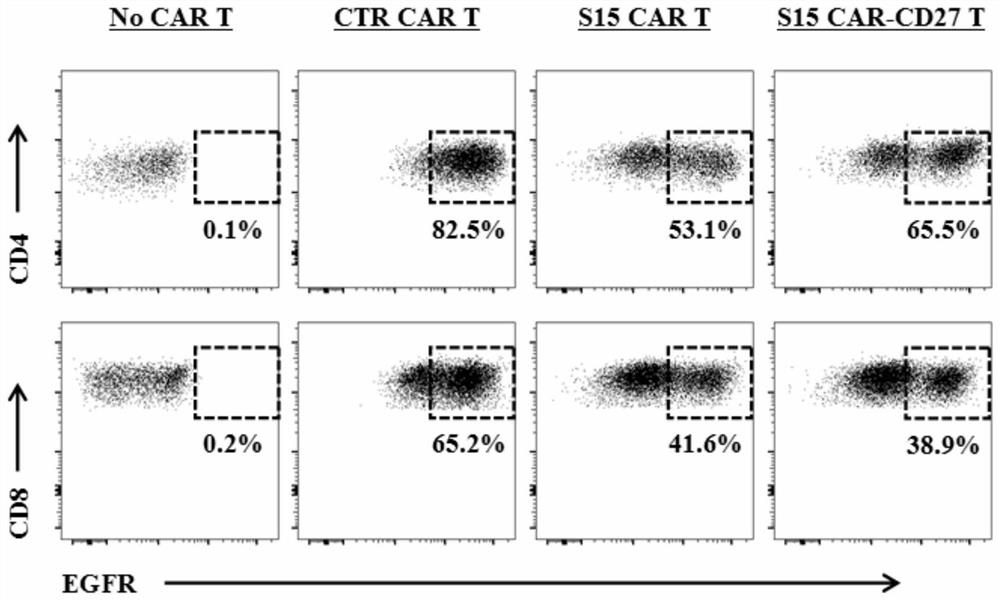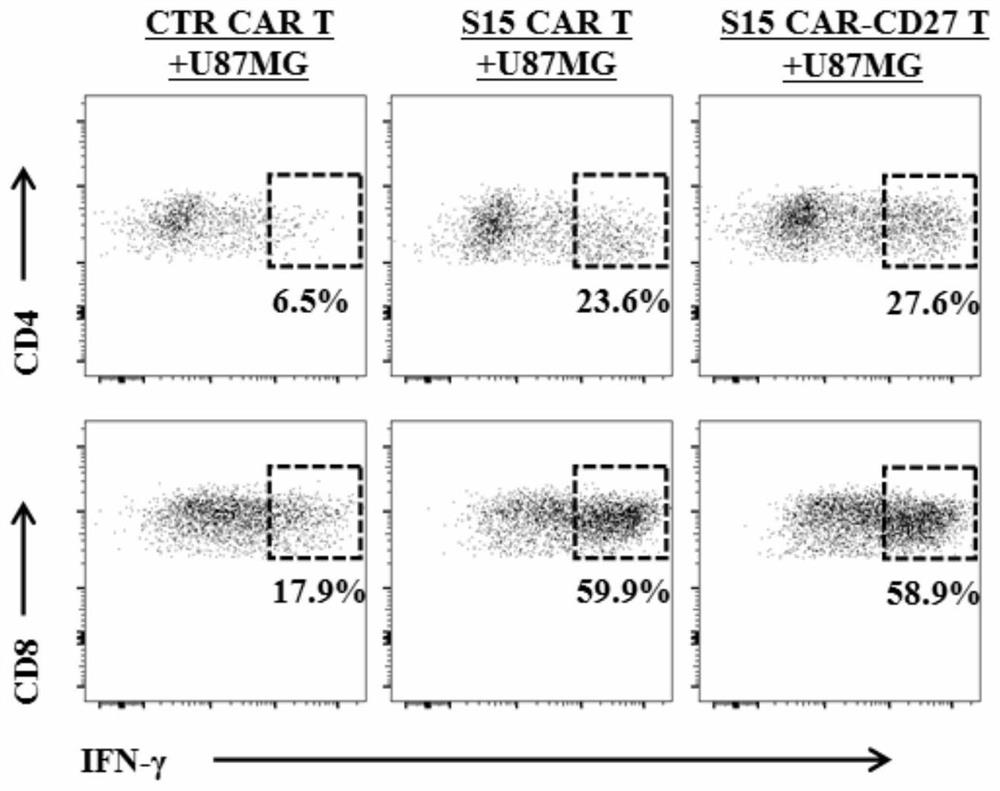A chimeric antigen receptor T-lymphocyte and its application in the preparation of products for treating solid tumors
A chimeric antigen receptor and cell technology, applied in the field of biomedicine, can solve the problems of no clinical efficacy, off-target toxicity, isolation of immune microenvironment, etc. Effects of tumor immune responses
- Summary
- Abstract
- Description
- Claims
- Application Information
AI Technical Summary
Problems solved by technology
Method used
Image
Examples
Embodiment 1
[0139] Example 1. Preparation of CAR-T cells
[0140] 1. Construction of retroviral vector
[0141] 1. Optimization of the full-length cDNA sequence of wild-type human CD27 gene
[0142] The full-length sequence of wild-type human CD27 gene cDNA is called nCD27. In order to make nCD27 more suitable for expression in human cells, while ensuring that the amino acid sequence encoded by nCD27 remains unchanged, the nCD27 sequence was codon optimized on the website http: / / sg.idtdna.com / site to obtain oCD27, The nucleotide sequence of oCD27 is shown in positions 2719-3501 of SEQ ID NO.1.
[0143] 2. Design and synthesis of S15-CAR-CD27 gene sequence
[0144] The S15-CAR-CD27 gene sequence sequentially includes the coding gene sequence of human CD8 leader peptide, the coding gene sequence of S15 scFv, the coding gene sequence of human CD8 hinge transmembrane region, the coding gene sequence of human 4-1BB intracellular region, the coding gene sequence of human CD3ζ The coding gen...
Embodiment 2
[0184] Example 2, CFSE labeling method to detect the specific killing effect of CAR-T cells on tumor cells
[0185] CFSE (CFDA-SE) is a cell staining reagent that can fluorescently label living cells. It can easily penetrate the cell membrane, covalently bind to intracellular proteins in living cells, and release green fluorescence after hydrolysis. The principle of CFSE labeling living cells can be used to label and quantify tumor cells, so as to detect the killing efficiency of CAR-T cells on tumor target cells. The specific method is: the target cells are equally divided into two groups and adjusted to the same cell density. Stained with low concentration and high concentration of CFSE respectively, wherein high concentration stained target cells and non-stained immune cells were co-cultured according to a certain ratio. After a period of incubation, the high-concentration stained tube of target cells (along with immune cells) was mixed in equal volume with the low-concent...
Embodiment 3
[0200] Example 3. Tumor transplantation model to detect the tumor killing effect of CAR-T cells in animals
[0201] Experimental materials: B-NDG severe combined immunodeficiency mice aged 5-6 weeks and weighing 18-22 g (Biocytogen Biotechnology Co., Ltd.).
[0202] Experimental grouping: The experimental materials were randomly divided into 3 experimental groups, with 5 mice in each group. The specific treatment methods for each group are as follows:
[0203] S15 CAR-CD27 T: B-NDG severe combined immunodeficiency mice were inoculated with U87-MG tumor cell solution (solvent: PBS) in the tail vein, the inoculation volume was 0.3ml (containing 2×10 6 tumor cells). Five days after tumor cell inoculation, the S15 CAR-CD27 T cell solution prepared in Example 1 (solvent is PBS) was injected into the tail vein of the mouse, and the injection volume of S15 CAR-CD27 T cells was 0.2ml (containing 5×10 6 S15 CAR-CD27 T cells).
[0204] S15 CAR T: B-NDG severe combined immunodeficien...
PUM
 Login to View More
Login to View More Abstract
Description
Claims
Application Information
 Login to View More
Login to View More - R&D
- Intellectual Property
- Life Sciences
- Materials
- Tech Scout
- Unparalleled Data Quality
- Higher Quality Content
- 60% Fewer Hallucinations
Browse by: Latest US Patents, China's latest patents, Technical Efficacy Thesaurus, Application Domain, Technology Topic, Popular Technical Reports.
© 2025 PatSnap. All rights reserved.Legal|Privacy policy|Modern Slavery Act Transparency Statement|Sitemap|About US| Contact US: help@patsnap.com



